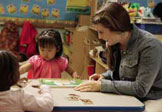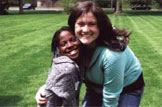Within Our Reach
Saint Mary’s builds a healthy relationship with the South Bend community
By Elizabeth Station
They’ve logged hundreds of hours as tutors and mentors at local schools. They’ve offered speech and language support to Latino families whose kids are struggling to learn English. They’ve helped tens of thousands of low-income residents prepare tax returns—for 35 years. They’ve volunteered at the Center for the Homeless, the YWCA, a west-side community clinic, and more.
Saint Mary’s students, faculty, and staff give a lot to the South Bend community, but what they receive in return may be even greater. Future nurses and social workers test ideas they learned in class against real-life situations. Student teachers sharpen the skills they need to work in diverse settings. And faculty members find valuable collaborators for teaching and research—as well as allies in their efforts to create caring citizens.

Hands On: Meghan MacKinnon ’07, a psychology major in the communicative disorders program, gets practice interacting with youngsters at the Early Childhood Development Center (ECDC). Besides providing quality childcare for the South Bend community, ECDC serves as a learning laboratory for Saint Mary’s students. “To be able to be so involved here has really, really helped,” says MacKinnon, who hopes to be a speech pathologist. A clinical practicum and home visits also gave her opportunities to work with local children: “They teach you so much more than you can ever teach them,” she says.
Evaluators from the Higher Learning Commission recently praised Saint Mary’s “healthy and productive relationship with the community of South Bend and the surrounding area” as a unique strength of the College. And as the relationship grows, both sides benefit. “Students are learning from amazing people in the community, and they are so grateful to have it as a laboratory,” says Associate Professor Catherine Pittman, whose clinical psychology students fan out into South Bend for practicum placements in legal services, hospice, rape crisis, and other programs. “I’m so proud of us, that we have this as a strength.”
Deep connections
The sheer number of Saint Mary’s partnerships in the local community is impressive—yet it’s the evolving quality of the relationships that excites those involved. As part of its mission, the College has always sought to cultivate a sense of social responsibility in students. But as outreach efforts blossom, so does a clearer sense of what kind of approaches best serve both sides.
One person shaping that approach is Dr. Carolyne Call, director of the Office for Civic and Social Engagement, who argues that the College has a “moral obligation” to build community relationships that are profound and long-term. As an example she cites Saint Mary’s partnership with Marquette Primary Center, an elementary school just across the river in South Bend’s ethnically diverse Marquette Park neighborhood.
At Marquette, Saint Mary’s students serve as classroom volunteers and after-school tutors. They’ve raised funds for school supplies, purchased Christmas gifts for needy families, and organized a book drive. They’ve offered grant writing services to teachers, taught health education, and created what school principal Carla Killelea calls a “life transforming” leadership program for fourth-grade girls. In turn, Marquette students and teachers have come to Saint Mary’s for academic programs.
Marquette is just one of 14 Title I schools in South Bend that serve children from high-poverty backgrounds. Call says that she could take a “scattershot approach” and send volunteers to many such schools, “and you assume and believe that they’re touching lives out there. The other model—which I’m taking out of reading (Father Basil) Moreau’s teachings on Christian education and Catholic social teaching—is to really focus and make a difference to one whole community, to do a lot for one place that’s deep.
“I want to integrate Marquette into Saint Mary’s and Saint Mary’s into Marquette, so that we have deep connections,” adds Call, who holds a Ph.D. in educational psychology. “That means taking responsibility for that school, so when they’re in hardship we suffer with them and help them, and when they’re succeeding, we rejoice with them.” The partnership is now in its third year, and Call says she’ll judge it a success when former Marquette fourth-graders have the academic skills and confidence to apply to, and graduate from, Saint Mary’s. “It will take awhile to get there,” she admits.
Learning goes both ways

Penpal Power: Tyonna Cohn (left) got close to Katie Cahill ’09 through a penpal program that matched fourth-grade girls from Marquette Primary Center in South Bend with Saint Mary’s mentors. Although their school is less than ten minutes away, “a lot of the girls at Marquette had never heard of Saint Mary’s before the program,” Cahill said. After a lively exchange of letters during the spring semester, Tyonna and her classmates met their mentors in person on a visit to campus in May. The experience was an eye-opener for both sides—the youngsters began to imagine themselves in college, and the oldsters got a sense of what it’s like to grow up on the other side of the river. Says Cahill, who is an elementary education major, “I’d do it again in a minute.”
Intentionality. Inclusiveness. Mutual benefits. Reciprocity. These are other crucial elements of healthy community relationships, says Bonnie Bazata, associate director of the Center for Women’s InterCultural Leadership (CWIL).
Bazata, who has a graduate degree in bilingual and multicultural education, spent 25 years working with community, school, and government organizations before coming to Saint Mary’s in 2002. The experience taught her that local residents are sometimes wary when universities step into their milieu, fearing they’ll take a top-down approach to problems or “plunder” the community for their research and walk away. CWIL and others at the College seek to overcome this in different ways. “There are many people who’ve lived in our community who have never been on our campus,” Bazata says. “You have to be intentional to break that down.”
That means inviting new people to the table when projects are planned and carried out, and “going out to tables that we’ve not been at before,” Bazata says. It means defining leadership broadly, so that CWIL engages diverse women who are “conduits” to their communities—whether they hold formal leadership positions or not. And it means connecting Saint Mary’s with the South Bend community in many ways and locations, or what Bazata says a professor of hers called “multiplying and thickening the strands of relationship.”
Several CWIL programs reflect this approach. One is Wellsprings of Wisdom, a three-day summer conference that brings women leaders from all walks of life to campus. CWIL also awards grants to “bridge College and community” by having students work with residents on mutually beneficial projects, and sponsors a program to strengthen women’s leadership at six local nonprofit agencies which, in turn, serve women.
Gladys Muhammad, associate director of the South Bend Heritage Foundation, collaborates with the College in many capacities. She supervises Saint Mary’s student interns at the Charles Martin Youth Center; she is president of the Department of Social Work’s advisory committee. Muhammad agrees that reciprocity makes the South Bend community’s relationship with Saint Mary’s a healthy one.
“The interns do valuable things that we need—it’s always been that way with our organization,” Muhammad says. At the same time, by doing research on violence in the community or supervising after-school programs, students gain knowledge that changes them as people. “They can learn about the world by going into South Bend,” Muhammad says. “They’re assets to us—and they’re learning. The learning goes both ways.”
Breaking down barriers
Often without recognition or fanfare, Saint Mary’s faculty members play a critical role in strengthening ties to the surrounding community. One in five professors has taught a service-learning course, and close to half have advised students’ service activities. Whether they teach nursing, education, religious studies, or math, many try to connect outreach activities to classroom learning.
Over the years, they’ve worked with staff and students to break down barriers that separated the College from the outside world. Before, some residents may have seen Saint Mary’s as a privileged outsider with little to offer its neighbors, but that perception has changed, according to Pittman. By working together on mutual goals, she says, “both sides get their stereotypes challenged and develop a depth of relationship that won’t allow those stereotypes to remain.”
“There’s a generosity of spirit that’s created a sense of hope,” agrees Marquette principal Carla Killelea. “We truly do welcome each other on each other’s turf.” Adds Gladys Muhammad, “Now the community really feels a part of Saint Mary’s College. It’s within our reach.”

